Structural Features Guiding the Design of Liquid-Crystalline Elastomeric Fluorescent Force Sensors
Abstract
1. Introduction
- Fluorophore content.
- Presence of long range orientational order in the host matrix.
- Length of the flexible spacer connecting the carbazole fluorophores to the polymer backbone.
- Anchoring mode (side-on or end-on) of the fluorogenic moieties.
- Type of mesophase exhibited by the elastomeric material.
2. Discussion
2.1. Design, Synthesis and Characterization of the Mechanofluorescent Elastomers
2.2. Structural Factors That Impact the Mechanofluorescent Behavior
2.2.1. Fluorophore Content in the Elastomeric Network
2.2.2. Presence of Long Range Orientational Order in the Host Matrix
2.2.3. Length of the Fluorophore Flexible Spacer
2.2.4. Anchoring Mode (End-on Versus Side-on)
2.2.5. Type of Mesophase Exhibited by the LSCE
2.2.6. Performance of the LSCE-Based Optical Force Sensors
3. Conclusions and Perspectives
Author Contributions
Funding
Conflicts of Interest
References
- Warner, M.; Terentjev, E.M. Liquid Crystal Elastomers; Clarendon Press: Oxford, UK, 2007. [Google Scholar]
- Demus, D.; Goodby, J.W.; Gray, G.W.; Spiess, H.W.; Vill, V. Handbook of Liquid Crystals; Wiley-VCH: Weinheim, Germany, 1998. [Google Scholar]
- Fleischmann, E.K.; Zentel, R. Liquid-Crystalline Ordering as a Concept in Materials Science: From Semiconductors to Stimuli-Responsive Devices. Angew. Chem. Int. Ed. 2013, 52, 8810–8827. [Google Scholar] [CrossRef]
- Finkelmann, H.; Nishikawa, E.; Pereira, G.G.; Warner, M. A New Opto-Mechanical Effect in Solids. Phys. Rev. Lett. 2001, 87, 015501-1–015501-4. [Google Scholar] [CrossRef]
- Hogan, P.M.; Tajbakhsh, A.R.; Terentjev, E.M. UV Manipulation of Order and Macroscopic Shape in Nematic Elastomers. Phys. Rev. E 2002, 65, 0411720. [Google Scholar] [CrossRef] [PubMed]
- Broer, D.J.; Crawford, G.P.; Zumer, S. The Liquid Crystals Book Series. Cross-Linked Liquid Crystalline Systems: From Rigid Polymer Networks to Elastomers; CRC Press: Boca Raton, FL, USA, 2011. [Google Scholar]
- Camacho-López, M.; Finkelmann, H.; Palffy-Muhoray, P.; Shelley, M. Fast Liquid-Crystal Elastomer Swims into the Dark. Nat. Mater. 2004, 3, 307–310. [Google Scholar] [CrossRef] [PubMed]
- Garcia-Amorós, J.; Finkelmann, H.; Velasco, D. Influence of the Photo-Active Azo Cross-Linker Spacer on the Opto-Mechanics of Polysiloxane Elastomer Actuators. J. Mater. Chem. 2011, 21, 1094–1101. [Google Scholar] [CrossRef]
- Garcia-Amorós, J.; Piñol, A.; Finkelmann, H.; Velasco, D. Azophenol-Based Liquid-Crystalline Elastomers for Light-Driven Actuators. Org. Lett. 2011, 13, 2282–2285. [Google Scholar] [CrossRef] [PubMed]
- Garcia-Amorós, J.; Martínez, M.; Finkelmann, H.; Velasco, D. Photoactuation and Thermal Isomerisation Mechanism of Cyanoazobenzene-Based Liquid Crystal Elastomers. Phys. Chem. Chem. Phys. 2014, 16, 8448–8454. [Google Scholar] [CrossRef]
- Chi, Z.; Zhang, X.; Xu, B.; Zhou, X.; Ma, C.; Zhang, Y.; Liu, S.; Xu, J. Recent Advances in Organic Mechanofluorochromic Materials. Chem. Soc. Rev. 2012, 41, 3878–3896. [Google Scholar] [CrossRef]
- Ma, Z.; Wang, Z.; Teng, M.; Xu, Z.; Jia, X. Mechanically Induced Multicolor Change of Luminescent Materials. ChemPhysChem 2015, 16, 1811–1828. [Google Scholar] [CrossRef]
- Xu, J.; Chi, Z. (Eds.) Mechanochromic Fluorescent Materials: Phenomena, Materials and Applications; RSC Smart Materials Series, No. 8; Royal Society of Chemistry: Cambridge, UK, 2014. [Google Scholar]
- Dong, Y.Q.; Lam, J.W.Y.; Tang, B.Z. Mechanochromic Luminescence of Aggregation-Induced Emission Luminogens. J. Phys. Chem. Lett. 2015, 6, 3429–3436. [Google Scholar] [CrossRef]
- Chen, J.; Tang, B.Z. Aggregation-induced Emission: Fundamentals and Applications; Qin, A., Tang, B.Z., Eds.; Wiley-VCH: Chichester, UK, 2014; Volume 1, pp. 307–322. [Google Scholar]
- Huang, X.; Qian, L.; Zhou, Y.; Liu, M.; Cheng, Y.; Wu, H. Effective Structural Modification of Traditional Fluorophores to Obtain Organic Mechanofluorochromic Molecules. J. Mater. Chem. C 2018, 6, 5075–5096. [Google Scholar] [CrossRef]
- Di, B.-H.; Chen, Y.-L. Recent Progress in Organic Mechanoluminescent Materials. Chin. Chem. Lett. 2018, 29, 245–251. [Google Scholar] [CrossRef]
- Jin, M.; Seki, T.; Ito, H. Mechano-Responsive Luminescence via Crystal-to-Crystal Phase Transitions between Chiral and Non-Chiral Space Groups. J. Am. Chem. Soc. 2017, 139, 7452–7455. [Google Scholar] [CrossRef]
- Garcia-Amorós, J.; Velasco, D. Optical mechanotransduction with carbazole-based liquid single-crystal elastomers. Macromol. Rapid Commun. 2015, 36, 755–761. [Google Scholar] [CrossRef]
- Wei, R.B.; He, Y.N.; Wang, X.G.; Keller, P. Photoluminescent Nematic Liquid Crystalline Elastomer with a Thermomechanical Emission Variation Function. Macromol. Rapid Commun. 2014, 35, 1571–1577. [Google Scholar] [CrossRef]
- Wei, R.B.; Zhang, H.X.; He, Y.N.; Wang, X.G.; Keller, P. Photoluminescent Nematic Liquid Crystalline Elastomer Actuators. Liq. Cryst. 2014, 41, 1821–1830. [Google Scholar] [CrossRef]
- Davis, D.A.; Hamilton, A.; Yang, J.; Cremar, L.D.; Van Gough, D.; Potisek, S.L.; Ong, M.T.; Braun, P.V.; Martínez, T.J.; White, S.R.; et al. Force-Induced Activation of Covalent Bonds in Mechanoresponsive Polymeric Materials. Nature 2009, 459, 68–72. [Google Scholar] [CrossRef]
- Kingsbury, C.M.; May, P.A.; Davis, D.A.; White, S.R.; Moore, J.S.; Sottos, N.R. Shear Activation of Mechanophore-Crosslinked Polymers. J. Mater. Chem. 2011, 21, 8381–8388. [Google Scholar] [CrossRef]
- Kim, T.A.; Robb, M.J.; Moore, J.S.; White, S.R.; Sottos, N.R. Mechanical Reactivity of Two Different Spiropyran Mechanophores in Polydimethylsiloxane. Macromolecules 2018, 51, 9177–9183. [Google Scholar] [CrossRef]
- Imato, K.; Kanehara, T.; Ohishi, T.; Nishihara, M.; Yajima, H.; Ito, M.; Takahara, A.; Otsuka, H. Mechanochromic Dynamic Covalent Elastomers: Quantitative Stress Evaluation and Autonomous Recovery. ACS Macro Lett. 2015, 4, 1307–1311. [Google Scholar] [CrossRef]
- Ducrot, E.; Chen, Y.; Bulters, M.; Sijbesma, R.P.; Creton, C. Toughening Elastomers with Sacrificial Bonds and Watching them Break. Science 2014, 344, 186–189. [Google Scholar] [CrossRef]
- Crenshaw, B.R.; Weder, C.J. Deformation Induced Color Changes in Melt-Processed Photoluminescent Polymer Blends. Chem. Mater. 2003, 15, 4717–4724. [Google Scholar] [CrossRef]
- Weder, C.J. Mechanoresponsive Materials. Mater. Chem. 2011, 21, 8235–8236. [Google Scholar] [CrossRef]
- Calvino, C.; Neumann, L.; Weder, C.; Schrettl, S. Approaches to Polymeric Mechanochromic Materials. J. Polym. Sci. Pol. Chem. 2017, 55, 640–652. [Google Scholar] [CrossRef]
- Muramatsu, T.; Sagara, Y.; Traeger, H.; Tamaoki, N.; Weder, C. Mechanoresponsive Behavior of a Polymer-Embedded Red-Light Emitting Rotaxane Mechanophore. ACS Appl. Mater. Interfaces 2019, 11, 24571–24576. [Google Scholar] [CrossRef]
- Sagara, Y.; Karman, M.; Seki, A.; Pannipara, M.; Tamaoki, N.; Weder, C. Rotaxane-Based Mechanophores Enable Polymers with Mechanically Switchable White Photoluminescence. ACS Cent. Sci. 2019, 5, 874–881. [Google Scholar] [CrossRef]
- Sulkanen, A.R.; Sung, J.; Robb, M.J.; Moore, J.S.; Sottos, N.R.; Liu, G.Y. Spatially Selective and Density-Controlled Activation of Interfacial Mechanophores. J. Am. Chem. Soc. 2019, 141, 4080–4085. [Google Scholar] [CrossRef]
- Zhao, D.; Li, G.; Wu, D.; Qin, X.; Neuhaus, P.; Cheng, Y.; Yang, S.; Lu, Z.; Pu, X.; Long, C.; et al. Regiospecific N Heteroarylation of Amidines for Full Color Tunable Boron Difluoride Dyes with Mechanochromic Luminescence. Angew. Chem. Int. Ed. 2013, 52, 13676–13680. [Google Scholar] [CrossRef]
- Li, G.; Song, F.; Wu, D.; Lan, J.; Liu, X.; Wu, J.; Yang, S.; Xiao, D.; You, J. Cation-Anion Interaction Directed Molecular Design Strategy for Mechanochromic Luminescence. Adv. Funct. Mater. 2014, 24, 747–753. [Google Scholar] [CrossRef]
- Zhang, Z.; Xue, P.; Gong, P.; Zhang, G.; Peng, J.; Lu, R. Mechanofluorochromic Behaviors of Biminoenolate Boron Complexes Functionalized with Carbazole. J. Mater. Chem. C 2014, 2, 9543–9551. [Google Scholar] [CrossRef]
- Tanioka, M.; Kamino, S.; Muranaka, A.; Ooyama, Y.; Ota, H.; Shirasaki, Y.; Horigome, J.; Ueda, M.; Uchiyama, M.; Sawada, D.; et al. Reversible Near-Infrared/Blue Mechanofluorochromism of Aminobenzopyranoxanthene. J. Am. Chem. Soc. 2015, 137, 6436–6439. [Google Scholar] [CrossRef]
- Matsunaga, Y.; Yang, J.-S. Multicolor Fluorescence Writing Based on Host-Guest Interactions and Force Induced Fluorescence Color Memory. Angew. Chem. Int. Ed. 2015, 54, 7985–7989. [Google Scholar] [CrossRef]
- Jiang, Y.; Gindre, D.; Allain, M.; Liu, P.; Cabanetos, C.; Roncali, J. A Mechanofluorochromic Push-Pull Small Molecule with Aggregation Controlled Linear and Nonlinear Optical Properties. Adv. Mater. 2015, 27, 4285–4289. [Google Scholar] [CrossRef]
- Yoshii, R.; Suenaga, K.; Tanaka, K.; Chujo, Y. Mechanofluorochromic Materials Based on Aggregation Induced Emission Active Boron Ketoiminates: Regulation of the Direction of the Emission Color Changes. Chem. Eur. J. 2015, 21, 7231–7237. [Google Scholar] [CrossRef]
- Nishida, T.; Ohta, S.; Xu, F.; Shinohara, K.; Kamada, T.; Akashi, H.; Takezaki, M.; Wakamatsu, K.; Orita, A. Dual Emission and Mechanofluorochromism of a V-Shaped π-System Composed of Disulfonyl-Substituted Dibenzocyclooctatetraenes. Org. Lett. 2016, 18, 3988–3991. [Google Scholar] [CrossRef]
- Xue, P.; Yao, B.; Liu, X.; Sun, J.; Gong, P.; Zhang, Z.; Qian, C.; Zhang, Y.; Lu, R. Reversible Mechanochromic Luminescence of Phenothiazine-based 10,10′-Bianthracene Derivatives with Different Lengths of Alkyl Chains. J. Mater. Chem. C 2015, 3, 1018–1025. [Google Scholar] [CrossRef]
- Zhang, Z.; Wu, Z.; Sun, J.; Yao, B.; Xue, P.; Lu, R. β-Iminoenolate Boron Complex with Terminal Triphenylamine Exhibiting Polymorphism and Mechanofluorochromism. J. Mater. Chem. C 2016, 4, 2854–2861. [Google Scholar] [CrossRef]
- Yang, H.; Ye, K.; Sun, J.; Gong, P.; Lu, R. Mechanofluorochromic Behaviors of Salicylaldimine Difluoroboron Complexes. Asian J. Org. Chem. 2017, 6, 199–206. [Google Scholar] [CrossRef]
- Zhao, J.; Chi, Z.; Yang, Z.; Mao, Z.; Zhang, Y.; Ubba, E.; Chi, Z. Recent Progress in the Mechanofluorochromism of Distyrylanthracene Derivatives with Aggregation-Induced Emission. Mater. Chem. Front. 2018, 2, 1595–1608. [Google Scholar] [CrossRef]
- Zhao, W.; He, Z.; Peng, Q.; Lam, J.W.Y.; Ma, H.; Qiu, Z.; Chen, Y.; Zhao, Z.; Shuai, Z.; Dong, Y.; et al. Highly Sensitive Switching of Solid-State Luminescence by Controlling Intersystem Crossing. Nat. Commun. 2018, 9, 3044. [Google Scholar] [CrossRef]
- Sharber, S.A.; Shih, K.-C.; Mann, A.; Frausto, F.; Haas, T.E.; Nieh, M.-P.; Thomas, S.W. Reversible Mechanofluorochromism of Aniline-Terminated Phenylene Ethynylenes. Chem. Sci. 2018, 9, 5415–5426. [Google Scholar] [CrossRef]
- Sagara, Y.; Karman, M.; Verde-Sesto, E.; Matsuo, K.; Kim, Y.; Tamaoki, N.; Weder, C. Rotaxanes as Mechanochromic Fluorescent Force Transducers in Polymers. J. Am. Chem. Soc. 2018, 140, 1584–1587. [Google Scholar] [CrossRef]
- Calvino, C.; Sagara, Y.; Buclin, V.; Haehnel, A.P.; del Prado, A.; Aeby, C.; Simon, Y.C.; Schrettl, S.; Weder, C. Mechanoresponsive, Luminescent Polymer Blends Based on an Excimer Forming Telechelic Macromolecule. Macromol. Rapid Commun. 2019, 40, 1800705. [Google Scholar] [CrossRef]
- Louis, M.; Sethy, R.; Kumar, J.; Katao, S.; Guillot, R.; Nakashima, T.; Allain, C.; Kawai, T.; Métivier, R. Mechano-Responsive Circularly Polarized Luminescence of Organic Solid-State Chiral Emitters. Chem. Sci. 2019, 10, 843–847. [Google Scholar] [CrossRef]
- Hirai, Y.; Wrona-Piotrowicz, A.; Zakrzewski, J.; Brosseau, A.; Guillot, R.; Métivier, R.; Allain, C. Mechanofluorochromism of pyrene-derived amidophosphonates. Photochem. Photobiol. Sci. 2020. [Google Scholar] [CrossRef]
- Li, Y.-X.; Chen, Y.-G.; Yu, Z.-F.; Yang, X.-F.; Nie, Y.; Cui, Y.; Sun, G.-X. Polymorph-Dependent Multicolor-Switchable Mechanofluorochromism of 1-(9-Anthryl)vinyl-3-(3-pyridyl)vinylbenzene: Molecular Conformation versus Intermolecular Interaction. J. Phys. Chem. C 2020, 124, 3784–3792. [Google Scholar] [CrossRef]
- Küpfer, J.; Finkelmann, H. Nematic Liquid Single Crystal Elastomers. Makromol. Chem. Rapid Commun. 1991, 12, 717–726. [Google Scholar] [CrossRef]
- Kim, H.; Zhu, B.; Adetiba, O.; Agrawal, A.; Ajayan, P.; Jacot, J.G.; Verduzco, R. Preparation of Monodomain Liquid Crystal Elastomers and Liquid Crystal Elastomers Composites. J. Vis. Exp. 2016, 108, 53688. [Google Scholar]
- Lovell, R.; Mitchell, G.R. Molecular Orientation Distribution Derived from an Arbitrary Reflection. Acta Cryst. 1981, A37, 135–137. [Google Scholar] [CrossRef]
- Mitchell, G.R.; Windle, A. Orientation in Liquid Crystal Polymers. In Developments in Crystal Polymers—2; Basset, D.C., Ed.; Science: London, UK; New York, NY, USA, 1988; pp. 115–175. [Google Scholar]
- Schatzle, J.; Kaufhold, W.; Finkelmann, H. Nematic Elastomers: The Influence of External Mechanical Stress on the Liquid-Crystalline Phase Behavior. Makromol. Chem. 1989, 190, 3269–3284. [Google Scholar] [CrossRef]
- Garcia-Amorós, J.; Bassaganyas, S.; Velasco, D. Exploring Optical Mechanotransduction in Fluorescent Liquid Crystal Elastomers. Phys. Chem. Chem. Phys. 2016, 18, 5108–5111. [Google Scholar] [CrossRef]
- Heras, D.; Reig, M.; Llorca-Isern, N.; Garcia-Amorós, J.; Velasco, D. Highly Efficient Elastomeric Fluorescence Sensors for Force Detection. ACS Appl. Polym. Mater. 2019, 1, 535–541. [Google Scholar] [CrossRef]
- Escalera-López, D.; Garcia-Amorós, J.; Velasco, D. Smectic-B Liquid Single Crystal Elastomers as Efficient Optical Mechanotransducers. Macromol. Chem. Phys. 2018, 219, 1700550. [Google Scholar] [CrossRef]
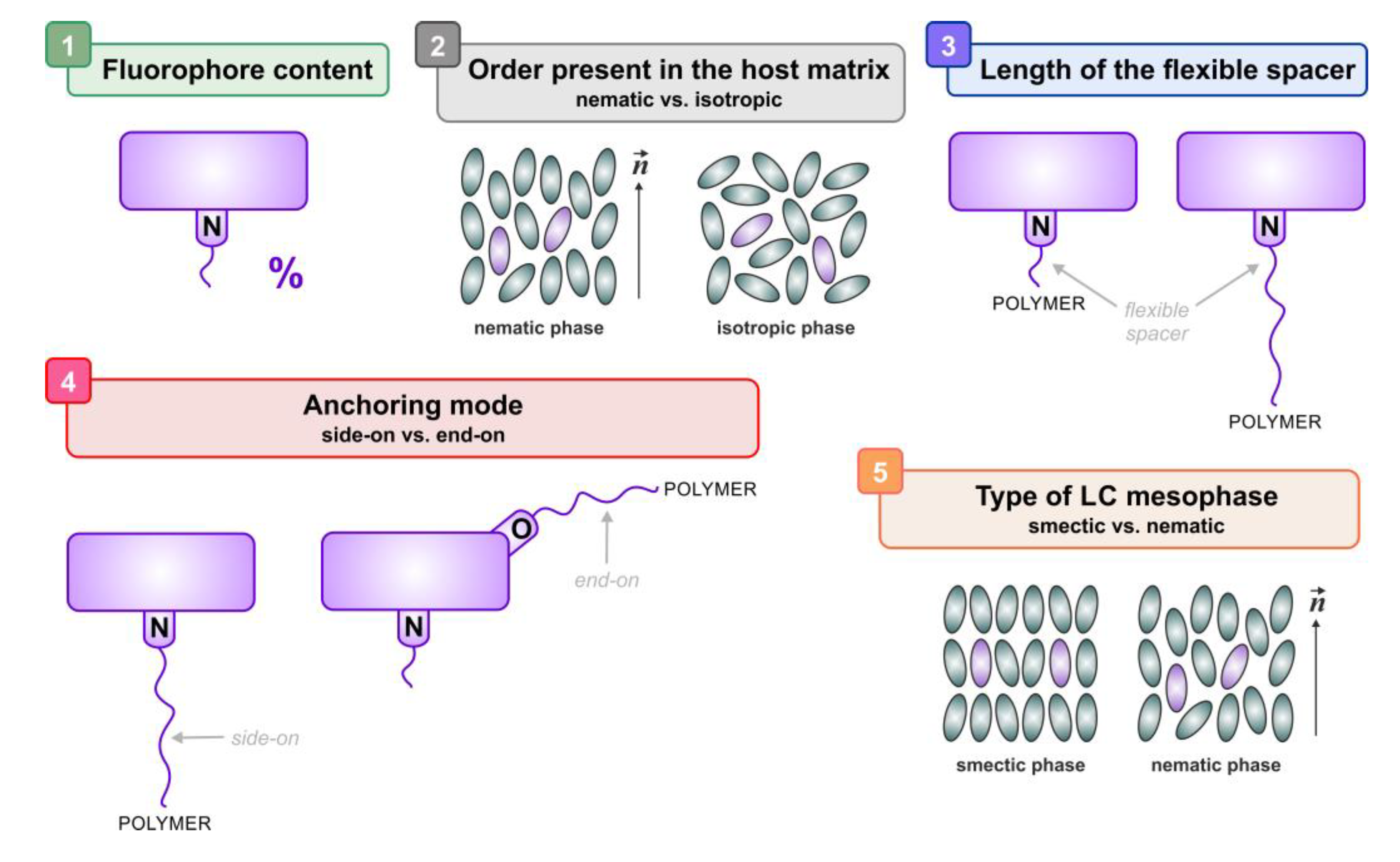
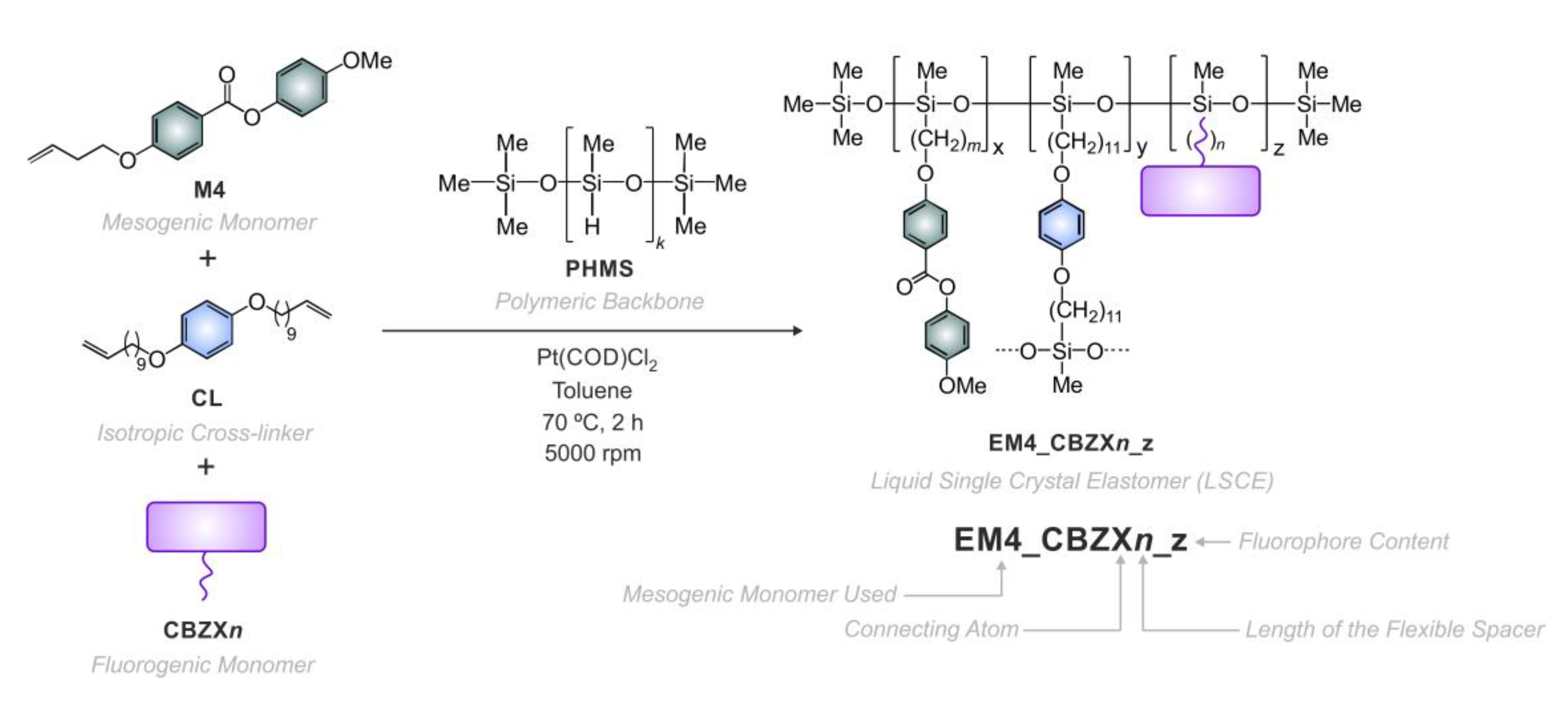
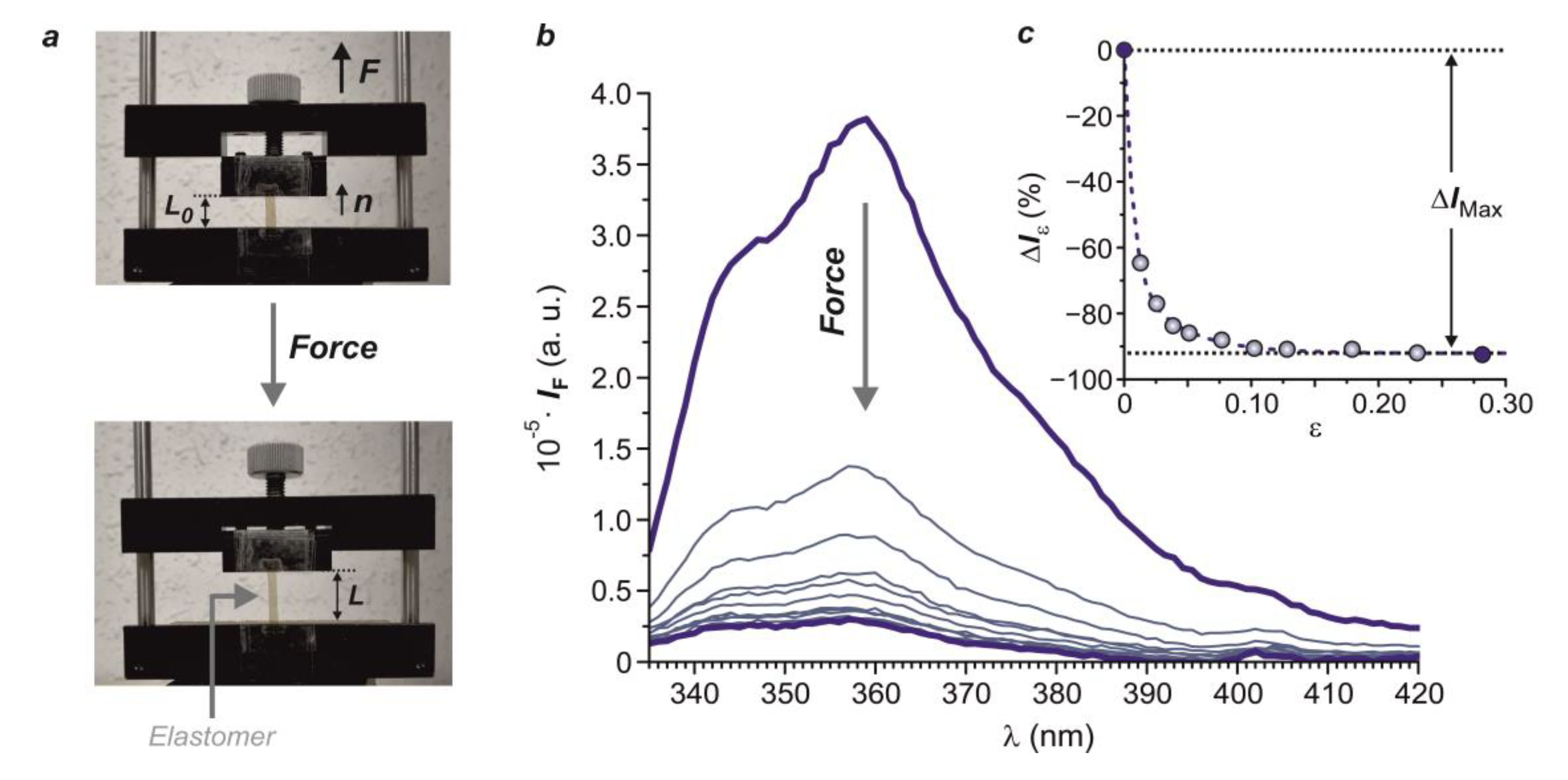

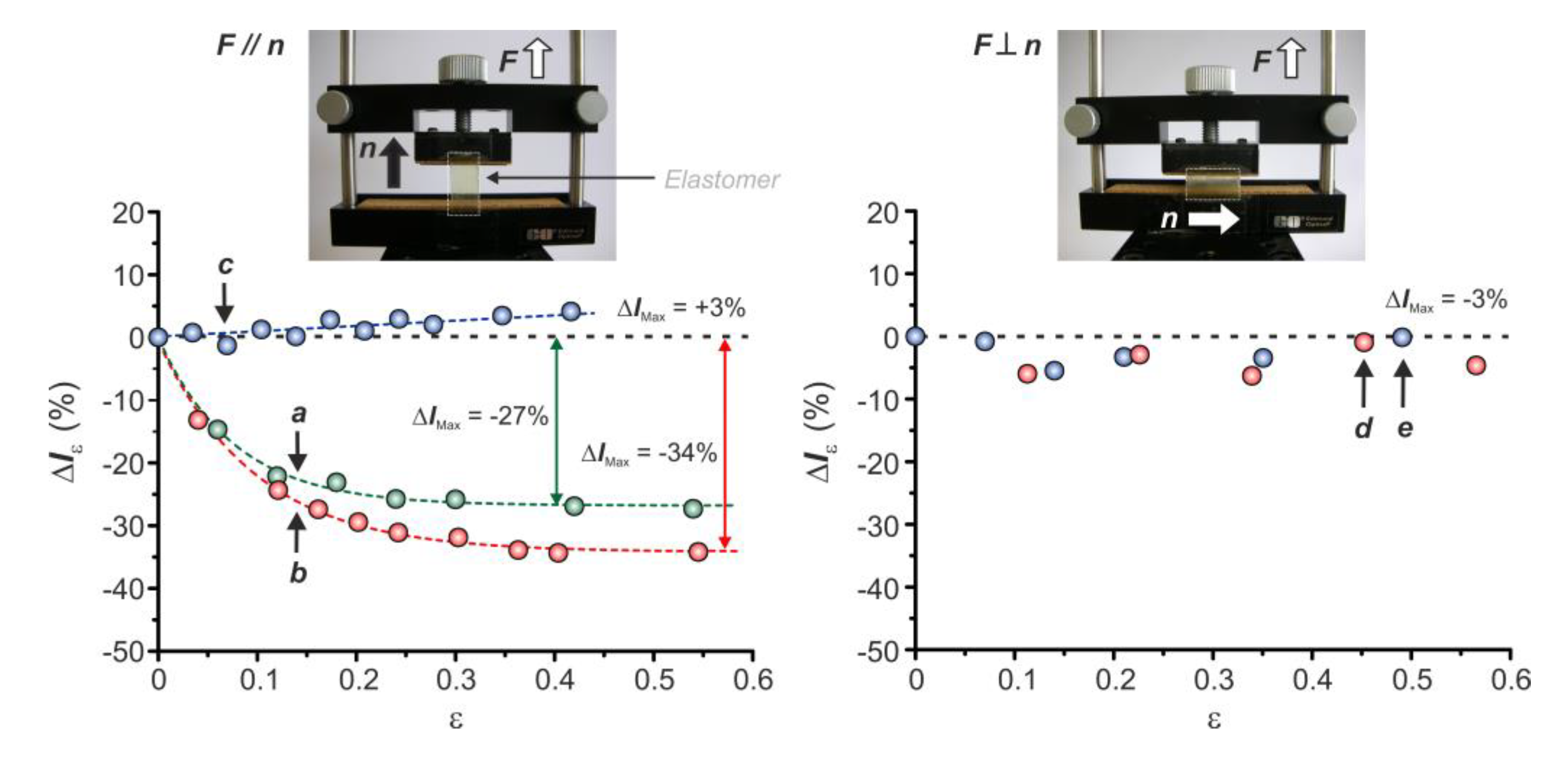

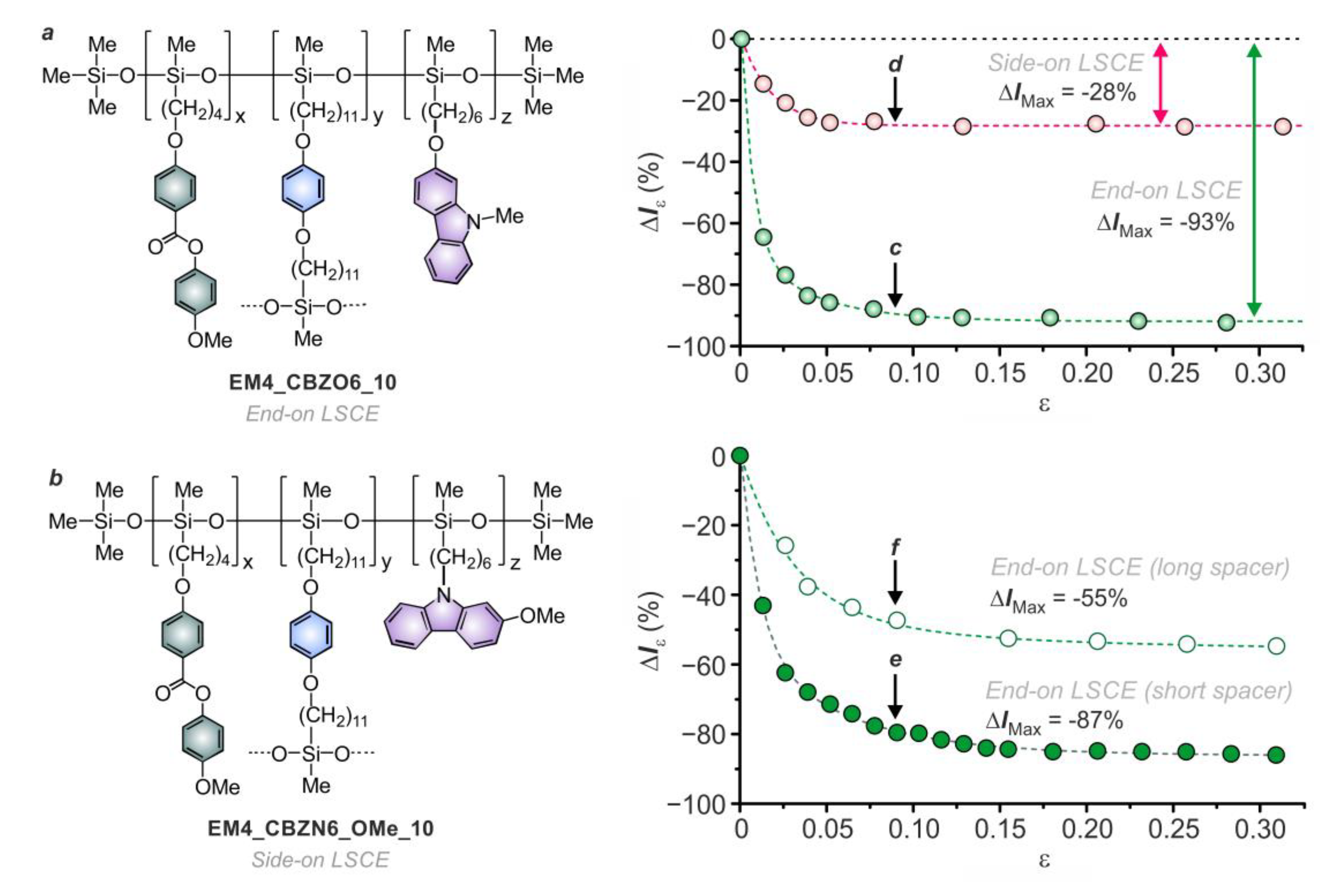


© 2020 by the authors. Licensee MDPI, Basel, Switzerland. This article is an open access article distributed under the terms and conditions of the Creative Commons Attribution (CC BY) license (http://creativecommons.org/licenses/by/4.0/).
Share and Cite
Garcia-Amorós, J.; Velasco, D. Structural Features Guiding the Design of Liquid-Crystalline Elastomeric Fluorescent Force Sensors. Appl. Syst. Innov. 2020, 3, 22. https://doi.org/10.3390/asi3020022
Garcia-Amorós J, Velasco D. Structural Features Guiding the Design of Liquid-Crystalline Elastomeric Fluorescent Force Sensors. Applied System Innovation. 2020; 3(2):22. https://doi.org/10.3390/asi3020022
Chicago/Turabian StyleGarcia-Amorós, Jaume, and Dolores Velasco. 2020. "Structural Features Guiding the Design of Liquid-Crystalline Elastomeric Fluorescent Force Sensors" Applied System Innovation 3, no. 2: 22. https://doi.org/10.3390/asi3020022
APA StyleGarcia-Amorós, J., & Velasco, D. (2020). Structural Features Guiding the Design of Liquid-Crystalline Elastomeric Fluorescent Force Sensors. Applied System Innovation, 3(2), 22. https://doi.org/10.3390/asi3020022




